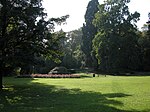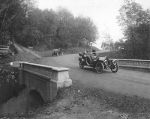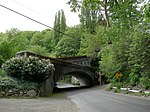Lacey V. Murrow Memorial Bridge

The Lacey V. Murrow Memorial Bridge is a floating bridge in the Seattle metropolitan area of the U.S. state of Washington. It is one of the Interstate 90 floating bridges that carries the eastbound lanes of Interstate 90 across Lake Washington from Seattle to Mercer Island. Westbound traffic is carried by the adjacent Homer M. Hadley Memorial Bridge. The Murrow Bridge is the second-longest floating bridge in the world, at 6,620 ft (2,020 m) (the longest is the Governor Albert D. Rosellini Bridge–Evergreen Point, a few miles north on the same lake). The original Murrow Bridge opened in 1940, and was named the Lake Washington Floating Bridge. It was renamed the Lacey V. Murrow bridge in 1967. The original bridge closed in 1989; the current bridge opened in 1993. Along with the east portals of the Mount Baker Ridge Tunnel, the bridge is an official City of Seattle landmark and a National Historic Civil Engineering Landmark. While the bridge originally had an opening span at the center of the bridge to allow a horizontal opening of 202 feet (62 m) for major waterborne traffic, the only boat passages currently are elevated fixed spans at the termini with 29 feet (8.8 m) of vertical clearance.
Excerpt from the Wikipedia article Lacey V. Murrow Memorial Bridge (License: CC BY-SA 3.0, Authors, Images).Lacey V. Murrow Memorial Bridge
South Day Street, Seattle Mount Baker
Geographical coordinates (GPS) Address Nearby Places Show on map
Geographical coordinates (GPS)
| Latitude | Longitude |
|---|---|
| N 47.58988 ° | E -122.27031 ° |
Address
Homer M. Hadley Memorial Bridge
South Day Street
98144 Seattle, Mount Baker
Washington, United States
Open on Google Maps








